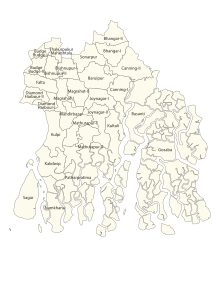Basanti | |
|---|---|
 Location of Basanti community development block in South 24 Parganas district | |
| Coordinates: 22°11′54″N88°42′50″E / 22.1983°N 88.7139°E | |
| Country | |
| State | |
| Division | Presidency |
| District | South 24 Parganas |
| Subdivision | Canning |
| Headquarters | Sonakhali |
| Government | |
| • Gram Panchayats | Amjhara, Basanti, Bharatgarh, Charabidya, Chunakhali, Foolmalancha, Jharkhali, Jyotishpur, Kanthalberia, Maszidbati, Nafarganj, Ramchandrakhali, Uttar Mokamberia |
| • Lok Sabha constituencies | Jaynagar |
| • Vidhan Sabha constituencies | Basanti, Gosaba |
| Area | |
• Total | 404.21 km2 (156.07 sq mi) |
| Population (2011) | |
• Total | 336,717 |
| • Density | 830/km2 (2,200/sq mi) |
| • Urban | 6,625 |
| Demographics | |
| • Literacy | 68.32 per cent |
| • Sex ratio | 966 ♂/♀ |
| Languages | |
| • Official | Bengali [1] [2] |
| • Additional official | English [1] |
| Time zone | UTC+05:30 (IST) |
| Website | s24pgs |
Basanti is a community development block that forms an administrative division in Canning subdivision of South 24 Parganas district in the Indian state of West Bengal.




















